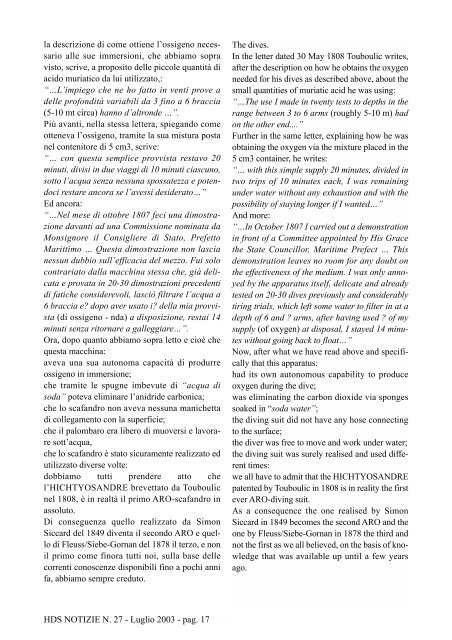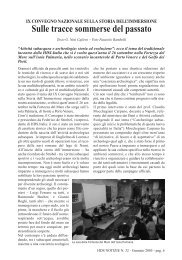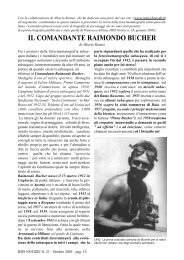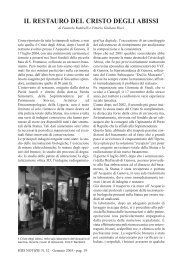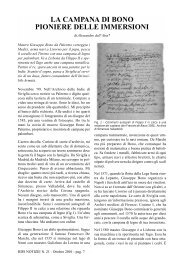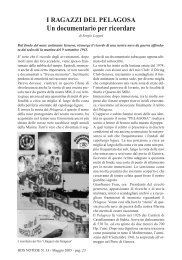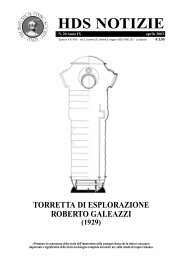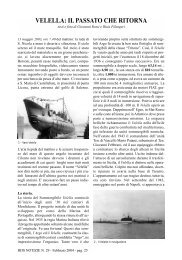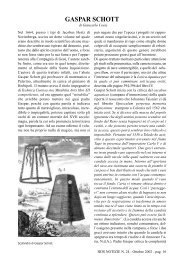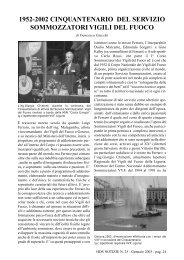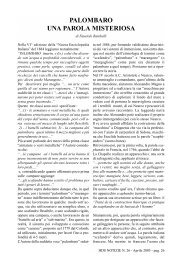HDS NOTIZIE N. 27 - Luglio 2003 - Historical Diving Society Italia
HDS NOTIZIE N. 27 - Luglio 2003 - Historical Diving Society Italia
HDS NOTIZIE N. 27 - Luglio 2003 - Historical Diving Society Italia
You also want an ePaper? Increase the reach of your titles
YUMPU automatically turns print PDFs into web optimized ePapers that Google loves.
la descrizione di come ottiene l’ossigeno necessario<br />
alle sue immersioni, che abbiamo sopra<br />
visto, scrive, a proposito delle piccole quantità di<br />
acido muriatico da lui utilizzato,:<br />
“…L’impiego che ne ho fatto in venti prove a<br />
delle profondità variabili da 3 fino a 6 braccia<br />
(5-10 mt circa) hanno d’altronde …”.<br />
Più avanti, nella stessa lettera, spiegando come<br />
otteneva l’ossigeno, tramite la sua mistura posta<br />
nel contenitore di 5 cm3, scrive:<br />
“… con questa semplice provvista restavo 20<br />
minuti, divisi in due viaggi di 10 minuti ciascuno,<br />
sotto l’acqua senza nessuna spossatezza e potendoci<br />
restare ancora se l’avessi desiderato…”<br />
Ed ancora:<br />
“…Nel mese di ottobre 1807 feci una dimostrazione<br />
davanti ad una Commissione nominata da<br />
Monsignore il Consigliere di Stato, Prefetto<br />
Marittimo … Questa dimostrazione non lascia<br />
nessun dubbio sull’efficacia del mezzo. Fui solo<br />
contrariato dalla macchina stessa che, già delicata<br />
e provata in 20-30 dimostrazioni precedenti<br />
di fatiche considerevoli, lasciò filtrare l’acqua a<br />
6 braccia e? dopo aver usato i? della mia provvista<br />
(di ossigeno - nda) a disposizione, restai 14<br />
minuti senza ritornare a galleggiare…”.<br />
Ora, dopo quanto abbiamo sopra letto e cioè che<br />
questa macchina:<br />
aveva una sua autonoma capacità di produrre<br />
ossigeno in immersione;<br />
che tramite le spugne imbevute di “acqua di<br />
soda” poteva eliminare l’anidride carbonica;<br />
che lo scafandro non aveva nessuna manichetta<br />
di collegamento con la superficie;<br />
che il palombaro era libero di muoversi e lavorare<br />
sott’acqua,<br />
che lo scafandro è stato sicuramente realizzato ed<br />
utilizzato diverse volte:<br />
dobbiamo tutti prendere atto che<br />
l’HICHTYOSANDRE brevettato da Touboulic<br />
nel 1808, è in realtà il primo ARO-scafandro in<br />
assoluto.<br />
Di conseguenza quello realizzato da Simon<br />
Siccard del 1849 diventa il secondo ARO e quello<br />
di Fleuss/Siebe-Gornan del 1878 il terzo, e non<br />
il primo come finora tutti noi, sulla base delle<br />
correnti conoscenze disponibili fino a pochi anni<br />
fa, abbiamo sempre creduto.<br />
<strong>HDS</strong> <strong>NOTIZIE</strong> N. <strong>27</strong> - <strong>Luglio</strong> <strong>2003</strong> - pag. 17<br />
The dives.<br />
In the letter dated 30 May 1808 Touboulic writes,<br />
after the description on how he obtains the oxygen<br />
needed for his dives as described above, about the<br />
small quantities of muriatic acid he was using:<br />
“…The use I made in twenty tests to depths in the<br />
range between 3 to 6 arms (roughly 5-10 m) had<br />
on the other end....”<br />
Further in the same letter, explaining how he was<br />
obtaining the oxygen via the mixture placed in the<br />
5 cm3 container, he writes:<br />
“… with this simple supply 20 minutes, divided in<br />
two trips of 10 minutes each, I was remaining<br />
under water without any exhaustion and with the<br />
possibility of staying longer if I wanted…”<br />
And more:<br />
“…In October 1807 I carried out a demonstration<br />
in front of a Committee appointed by His Grace<br />
the State Councillor, Maritime Prefect … This<br />
demonstration leaves no room for any doubt on<br />
the effectiveness of the medium. I was only annoyed<br />
by the apparatus itself, delicate and already<br />
tested on 20-30 dives previously and considerably<br />
tiring trials, which left some water to filter in at a<br />
depth of 6 and ? arms, after having used ? of my<br />
supply (of oxygen) at disposal, I stayed 14 minutes<br />
without going back to float…”<br />
Now, after what we have read above and specifically<br />
that this apparatus:<br />
had its own autonomous capability to produce<br />
oxygen during the dive;<br />
was eliminating the carbon dioxide via sponges<br />
soaked in “soda water”;<br />
the diving suit did not have any hose connecting<br />
to the surface;<br />
the diver was free to move and work under water;<br />
the diving suit was surely realised and used different<br />
times:<br />
we all have to admit that the HICHTYOSANDRE<br />
patented by Touboulic in 1808 is in reality the first<br />
ever ARO-diving suit.<br />
As a consequence the one realised by Simon<br />
Siccard in 1849 becomes the second ARO and the<br />
one by Fleuss/Siebe-Gornan in 1878 the third and<br />
not the first as we all believed, on the basis of knowledge<br />
that was available up until a few years<br />
ago.


